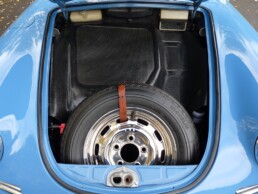60 K 10, here is the name of the three prototypes developed by Ferdinand Porsche for the race. They bear a striking resemblance to what the 356 will later be, we can already see the beginnings of the traits that will make the brand famous for 60 years… Lowered, with aluminum bodywork and fitted with a pushed engine, they were advertised at 140 km/h. It was on June 8, 1948 that project 356 (for 356th project of the design office) was born, a vehicle very close to the beetle with its rear cantilever engine.
The first 46 copies gradually left the workshop and were divided between coupés and convertibles.
It was at the Geneva Motor Show that the brand appeared on the international scene for the first time.
It was in March 1951 that the milestone of 500 copies was reached, which Ferdinand Porsche unfortunately did not know, the latter died on January 30 of the same year, leaving behind a young company to his son, Ferry. It will not be long before the brand reaches 1,000 copies in 1952 and the Porsche 356 evolves. Over the years it matures, is equipped with more efficient brakes and the engines are gradually pushed. The 356 B can be classified into two types, the T5 and T6 between which there are some slight aesthetic changes. The B series notably introduces a new version of the 1600 named “super 90” in relation to its power of 90 hp. Meanwhile the brakes are now alloy, but still drums.
The ultimate evolution of the Porsche 356, the C model was presented in Frankfurt in 1962.
Evolution of the very last 356 B, the C appears more attractive than ever.
Aesthetically, it adopts new rims but fully retains the line of the 356 B.
In the cabin, the dashboard is simply slightly modified, the seats are more welcoming and the driving position progresses a little.


















